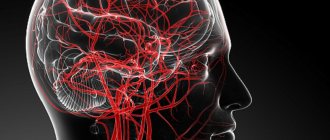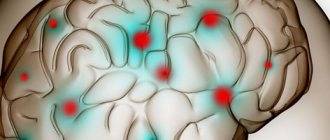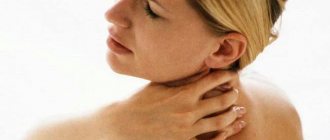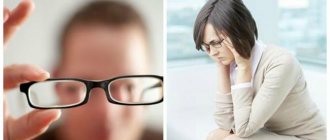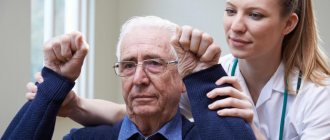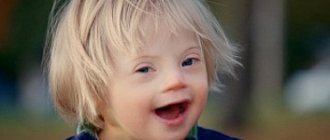Neurologist
Chudinskaya
Galina Nikolaevna
Experience 29 years
Neurologist, member of the Association of Interdisciplinary Medicine
Make an appointment
Stroke is an acute cerebrovascular accident (CVA) that causes damage and death of nerve cells. The name itself comes from the Latin word “insultus”, translated as “strike, attack”. Previously, the pathology was called apoplexy (apoplexy), as the Greeks called paralysis - one of its main symptoms and consequences.
The disease is more common than acute myocardial infarction. Over 15 million cases are registered annually in the world. They account for 10% of all deaths (almost 6 million per year), which makes stroke the “No. 2 cause of death” on the planet after coronary heart disease (CHD). But in most episodes, the consequence of stroke is not death, but limitation of life activity; this is the leading cause of disability among people in the older age group.
About 60% of stroke patients have persistent neurological disorders that interfere with their normal lifestyle. Typical abnormalities include impaired movement and ability to move, difficulty swallowing, a high risk of speech and visual disorders, falls, and fractures. Emotional (depression) and cognitive (up to the stage of dementia) disorders are often observed.
Symptoms, signs of stroke
All symptoms of a cerebral stroke develop sharply, quickly, and appear suddenly:
- weakness, numbness, loss of sensitivity, paralysis of one half of the body or face, arms, legs;
- intense headache, described by patients as the worst in life;
- speech impairment (a person cannot speak or has difficulty doing so), misunderstanding of the interlocutor’s speech;
- deterioration in clarity of vision, it is unfocused or completely absent in one eye;
- dizziness, loss of coordination of movements, balance, walking, and sometimes loss of consciousness;
- nausea, vomiting.
Important: if you witness such symptoms, call an ambulance immediately! A stroke is an emergency condition that requires immediate emergency hospitalization!
Uninformed people can easily mistake such signs for alcohol or drug intoxication, so it is extremely important to know and distinguish the symptoms. After all, the speed of medical care plays a key role here - literally minutes count, death from stroke is directly related to delay. The sooner the victim is hospitalized, the less the consequences of a stroke will be and the higher the chances of saving life.
To make it easier to determine the occurrence of a stroke, doctors recommend using three basic recognition techniques. They are called the “UZP” rule, an abbreviation for the first letters of the words denoting the action that a person is asked to perform:
- U - smile. During a stroke, the smile often looks “crooked”, unnaturally skewed, when one corner of the mouth is lowered and the other is raised.
- Z – speak. Say a simple sentence like “Today they promised good weather.” Often (but not always!) there is incorrect pronunciation.
- P – raise your arms at the same time. If one arm involuntarily lags behind in movement or drops, there is a high probability of stroke.
When calling an ambulance, be sure to describe your symptoms to the dispatcher; such cases require calling a specialized resuscitation team and transporting them to a specialized clinic. You should not try to transport the patient to the hospital yourself, since not all medical institutions can provide the required set of emergency medical measures and precious time will be lost.
First aid for stroke
Before the medical team arrives, you need to provide assistance to the patient:
- Place in a horizontal position, raising the shoulders, neck and head 30° relative to the body (place a pillow, a cushion of clothing).
- Provide access to fresh air (unfasten tight clothing, open a window).
- Turn his head to the side to prevent vomit from entering the respiratory tract.
Under no circumstances should you give food or water - partial paralysis of the swallowing organs can cause food or drink to enter the respiratory system and subsequent suffocation. In other words, a person may choke or choke, which is likely to cause death due to stroke.
Features of a stroke in an old person
Stroke is a disease that requires emergency medical intervention. At different ages, the consequences of pathology will differ markedly. Patients over 70–80 years of age have a very severe clinical picture of the disease and minimal chances of survival, especially if a major stroke occurs.
It is in old age that 45% of patients who have had an attack are susceptible to subsequent coma in the first few days. After a stroke, an old person's prognosis for restoring the body's functional capabilities will be much worse than that of people under 50 years of age. Even if the patient manages to survive, there is a high chance of remaining disabled, most often bedridden.
Elderly people, fearing to upset their loved ones, often ignore the symptoms of the disease themselves, thereby aggravating their situation during a stroke. When working with such patients, some characteristic features of the course of the disease should be taken into account:
- Stroke increases rapidly and is more severe, since the body of an old person is subject to age-related changes and is burdened by other chronic diseases.
- Elderly people put off visiting a medical facility, citing the fact that this is a common ailment at their age. Unfortunately, age plays a negative role, since at the time of a stroke, brain tissue is affected much faster in an older person.
- In older patients, major ischemic stroke is diagnosed more often than in 30–40 year olds.
- The most common cause of attacks after 60 years is the presence of atherosclerotic plaques.
We recommend
“High blood pressure in older people: treatment, prevention and traditional methods of combating the disease” Read more
Causes of stroke
A stroke is caused by a disruption in the normal flow of blood to an area of the brain due to stenosis (narrowing), embolism (blockage), or rupture of a cerebral artery. If brain cells do not receive enough oxygen and nutrients, they die.
Embolism and stenosis most often develop against the background of atherosclerosis, when an atherosclerotic plaque narrows the lumen of the vessel and promotes the formation of a blood clot. A detached blood clot completely blocks the vessel, this is called thromboembolism. Vascular rupture (essentially, intracerebral hemorrhage) can occur with arterial hypertension (high blood pressure), aneurysm, or severe traumatic brain injury.
There are a number of pathologies, the presence of which significantly increases the risk of stroke:
- cerebral atherosclerosis;
- atrial fibrillation;
- myocardial infarction;
- high blood pressure;
- varicose veins;
- blood clotting disorder;
- diabetes;
- obesity;
- sedentary lifestyle;
- smoking, alcoholism.
The risk of developing this terrible disease increases after 30 years of age, especially in weather-dependent people, as well as in those exposed to chronic stress, regular overwork, and constant excessive physical exertion.
Statistical data
Death due to stroke and signs of the early stage of the disease are being recorded more and more often in Russia. Stroke is rapidly getting younger. Factors affecting the unfavorable environmental situation in large cities, constant stressful situations at work and at home, and abuse of alcohol and tobacco products. In world practice, stroke ranks third in the overall statistics of all deaths, in Russia it ranks second.
A higher percentage of mortality is recorded from the hemorrhagic form of cerebral hemorrhage.
| View | Mortality percentage |
| Ischemic | 12-17% |
| Intracerebral hemorrhage | 53-83% |
| Subarachnoid | 33-65% |
The gender distribution of risk, or how men and women die from stroke, is as follows:
- death from stroke in women occurs in more than 43% of cases;
- men die less often – 36.6%.
Rehabilitation and prevention play an important role, because statistically the highest percentage of mortality is recorded after a recurrent stroke.
For information. Only 59.9% of patients who apply receive qualified and timely assistance. The rest self-medicate (34%), others do not receive help at all (5.7%).
Classification of strokes
There are two types of stroke - ischemic and hemorrhagic:
- Ischemic (also known as cerebral infarction) occurs when the lumen of a blood vessel in the neck or brain is narrowed or completely blocked by a blood clot.
- Hemorrhagic - when hemorrhage occurs in the brain due to a rupture of the vessel wall, as a result of which nerve tissue is compressed, cerebral edema and displacement of brain structures are formed.
- Separately, a transient ischemic attack (TIA) should be mentioned - a short, from 10 minutes to several hours, disturbance of blood circulation in the brain. It is accompanied by symptoms characteristic of a stroke (headache, paresis, speech disorder, etc.), but differs in the short duration of their manifestations and the reversibility of the disorders. In most cases, TIA goes away on its own, without medical attention.
Sometimes people do not attach much importance to TIA due to the transience of this condition and the absence of complaints afterwards. But a TIA indicates a high risk of a full-blown ischemic stroke in the future, often within a few days or weeks. Therefore, such a patient must undergo a full examination to prevent stroke.
About 80% of all strokes are ischemic. There is a generally accepted classification of ischemic stroke according to the mechanism of development:
- Atherothrombotic - among all others, it is recorded in 40-60% of cases. Occurs as a result of atherosclerotic lesions of the precerebral or great cerebral artery. I get sick more often in people over 60 years of age. Often this type of stroke occurs during sleep, preceded by a TIA attack.
- Embolic stroke - develops against the background of mitral or aortic valve disease, after myocardial infarction, with endocarditis, paroxysm of atrial fibrillation, post-infarction aneurysm. The onset is sudden, in a state of wakefulness, the predominant age of patients is 50-65 years.
- Lacunar - due to damage to the small cerebral arteries that supply the deep parts of the brain. A type of stroke characterized by concomitant high blood pressure develops gradually over several hours.
- Hemodynamic – occurs in the presence of severe stenosis of the main arteries, subject to a sharp drop in blood pressure due to:
- orthostatic hypotension;
- deep sleep;
- hyperventilation;
- overdose of antihypertensive drugs;
- myocardial infarction;
- heart rhythm disturbances, etc.
What does clinical death from a stroke look like?
If the ischemic process progresses, the prognosis will be unfavorable. There are three main signs (conditions) by which clinical death is determined. The first 4 minutes are decisive. After establishing the symptoms of clinical death, resuscitation measures are taken. If they are unsuccessful, the onset of biological death is recorded.
Additionally, the table shows what death from a stroke looks like.
| State | Short description |
| Coma |
|
| Apnea | Complete absence of respiratory activity, no respiratory movements of the chest. |
| Asystole |
|
Death after acute hemorrhage in the brain area can be caused by various reasons (from pulmonary edema to cardiac arrest). Only prevention of any pathologies of the cardiovascular system, blood supply, nervous system, a healthy lifestyle, as well as early diagnosis of stroke can help reduce the rate of death from cerebral hemorrhage.
An important role is played by the provision of competent assistance at the level of the local clinic, since often with the first symptoms of a stroke the patient turns to the doctor of this particular medical institution.
Diagnosis of stroke
Since the therapeutic window for the treatment of acute stroke is limited in time, it is extremely important to make a diagnosis as quickly as possible. Examination of the patient by a specialist and diagnostic tests (including neuroimaging) are carried out almost simultaneously. The choice of neuroimaging method is based on the neurological status and condition of the patient; for example, about 40% of patients with stroke cannot undergo MRI due to contraindications.
Clinical examination remains an important part of diagnosis. At this stage, anamnesis is collected, a general examination, and a neurological examination. Information about the time of onset of symptoms and previous stroke is especially important. A neurological examination is intended not only to establish stroke and its causes, but also to exclude diseases that imitate it, and to differentiate it from pathologies with a similar clinical picture.
For people suspected of having a stroke or TIA, emergency computed tomography (CT) or magnetic resonance imaging (MRI) of the brain is recommended.
Brain CT is today considered the international standard for diagnosing stroke; the accuracy of diagnosing hemorrhage with CT is almost 100%. Spiral CT reliably identifies most conditions simulating stroke (tumor, subdural hematoma, etc.) and distinguishes acute ischemic stroke from hemorrhagic.
MRI is more sensitive and can detect clear changes in the medulla, brainstem and cerebellum that are invisible with conventional CT. The procedure is especially effective in diagnosing stroke in the vertebrobasilar region, lacunar stroke, and acute ischemia. But MRI is less informative for hemorrhages.
Ultrasound methods help in diagnosing stenotic processes. Duplex scanning combines real-time ultrasound imaging to assess the anatomical structure of the arteries with pulsed Doppler analysis of blood flow at any part of the lumen of the vessel. This makes it possible to identify severe carotid artery stenosis at an early stage, for which catheterization angiography and surgery—carotid endarterectomy—are indicated.
Vascular imaging should also be performed as quickly as possible, including:
- CT angiography;
- MR angiography;
- catheter angiography;
- duplex ultrasonography.
Laboratory diagnostics should also be performed as an emergency; basic tests include:
- general clinical blood test with platelet count, hematocrit;
- determination of blood group, Rh factor;
- biochemical blood test: sugar, urea, creatinine, bilirubin, cholesterol, etc.;
- electrolytes (potassium, sodium);
- clinical urine analysis.
Other additional blood tests are possible as prescribed by your doctor.
Rehabilitation and recovery after stroke
The recovery program after a stroke should be comprehensive and include:
- quality patient care,
- drug treatment,
- restoration of lost skills through gymnastics,
- physiotherapy,
- massage.
Rehabilitation measures also include psychotherapeutic assistance and social adaptation. The rehabilitation period takes several months or years and requires patience and perseverance.
When drug therapy is used:
- aspirin,
- beta blockers,
- diuretics,
- ACE inhibitors,
- calcium channel blockers statins,
- muscle relaxants,
- anticonvulsants,
- nootropic and neurotrophic agents,
- antidepressants.
Rehabilitation at home
Treatment after a stroke at home is carried out under the constant supervision of a neurologist. It is also aimed at preventing recurrent strokes, the risks of which are significant in the first two years after a stroke.
Treatment includes a set of rehabilitation measures related to the restoration of vital functions (movement, thinking, speech, vision, hearing), drug therapy, exercise therapy and breathing exercises.
Rehabilitation in a sanatorium
Treatment in sanatoriums is aimed at:
- consolidation of treatment results,
- normalization of blood circulation,
- prevention of recurrent stroke,
- increased performance and restoration of motor activity,
- maintaining psycho-emotional health.
The following basic methods are used:
- hardware treatment,
- manual therapy,
- exercise therapy,
- classes with a speech therapist,
- massage,
- acupuncture,
- laser treatment,
- magnetotherapy,
- hirudotherapy.
Sanatoriums for rehabilitation after a stroke are available to anyone who has had the disease, except those who:
- can't take care of himself
- suffers from severe arrhythmia,
- has mental disorders
- serious speech and motor impairments,
- epilepsy.
When choosing a sanatorium, preference is given to treatment in a specialized sanatorium with proven programs for recovery after strokes. A set of procedures requires recommendations from the treating neurologist.
Restoring a hand after a stroke
Due to impaired blood circulation in the brain, the hand after a stroke often loses sensitivity and mobility. It is necessary to begin rehabilitation of the hand in a timely manner so that the regeneration of nerve cells in the brain occurs and its mobility is restored. Most often, the hand goes numb and ceases to obey when the right hemisphere of the brain and cerebellum are damaged.
Psychological and physical rehabilitation helps restore the hand. Faith in treatment will help the patient recover faster and undergo the rehabilitation course more easily. It includes:
- drug therapy,
- exercise therapy,
- massage,
- rubbing and compresses,
- hydrotherapy,
- acupuncture,
- activities to develop fine motor skills.
The hand needs simple exercises:
- flexion-extension of fingers,
- grabbing objects
- raising your hand up,
- spreading to the sides
- modeling,
- writing and drawing.
It is important for the patient to be encouraged to eat and dress independently. Swimming is recommended if possible.
Rehabilitation exercises should be performed 2-3 times a day, physical therapy is prescribed once a day for 3-4 months. The duration of each rehabilitation session is from 10 minutes to an hour.
The task of the rehabilitation therapist is to help the patient remember how he moved his arm before the stroke and restore this action. At first, moving at least one finger can be considered a success. It is important to remember that restoring a hand after a stroke is a very long process, which does not imply giving up rehabilitation due to physical pain and despair from poor results.
It is correct to start the exercises with the large muscles of the healthy arm, mentally repeating all the movements of the affected arm. Exercises need to be changed daily, using objects or special exercise equipment. It is important to work out the entire arm, paying special attention to the fingers and shoulder muscles.
Simple exercises for every day include:
- clenching your fingers into a fist and straightening,
- flexion and extension of the arm at the elbow,
- clapping hands,
- grabbing objects
- rolling a ball on a hard surface.
After the first month of simple exercises, you can move on to training your shoulders and forearms with light dumbbells. Wrist workout includes:
- sculpting,
- letter,
- drawing,
- training with a rubber ring.
To develop the entire limb, you can train using checkers and chess, a Rubik's cube, a children's construction set, collecting buttons or matches.
At the same time, drug therapy is used to restore the arm, in which baclofen, tizanidin-teva, klonopin, and phenol are used.
After medical advice, you can use folk remedies to restore your hand. The most popular of them:
- ointment based on bay leaves and pine needles;
- compresses with alcohol tincture of pine cones and sage (200 ml of vodka per tablespoon of herb);
- sage baths,
- ointments made from propolis and fat.
About half of patients suffer from arm paralysis after a stroke, while 75% return their limbs to normal after six months of rehabilitation procedures.
Exercises for stroke survivors
Complexes and special programs are prepared by the treating neurologist, and the exercises can be performed at home or in exercise therapy rooms. Exercises include complexes of physical therapy, aerobic exercises, complexes for the restoration of motor activity and balance training.
The full rehabilitation package includes:
- massage of the limbs - every 3 hours daily;
- extension/flexion of arms and legs - 2 times a day for half an hour;
- exercises to restore speech and memory;
- breathing exercises.
Exercises can be physical and mental. The latter restore memory, speech, vision, hearing, concentration and thinking.
When performing any exercise, it is important that the patient feels good. If you experience headaches, dizziness, weakness, changes in blood pressure and other symptoms of circulatory disorders, exercise should be stopped.
Every patient who has suffered a stroke needs to undergo long-term rehabilitation, which can last for years. At the same time, it is important to remember that recovery after a stroke is not only possible, but also not uncommon, and to make every effort for successful rehabilitation.
Exercise therapy
Exercise therapy often begins after an acute period of stroke in a hospital. After discharge, as recommended, you can continue them at home. Exercise therapy relieves muscle spasms, restores motor activity and cerebral circulation.
If a stroke has completely or partially paralyzed a person, then the exercises in the first month of training only include changing the patient’s body position every three hours.
After this, they begin to perform a passive exercise therapy complex: massage and extension/flexion of the arms and legs. After the first successes in independent movements, you can perform more active exercises.
Medicine defines four stages of exercise therapy training for patients after a stroke:
- acute (classes in the first weeks after a stroke in a hospital);
- early (classes in the first six months in rehabilitation centers or at home);
- late (in six months of the second half of the first year after the stroke);
- long-term (one year after the stroke).
Exercise therapy training is carried out at a certain time, several times a day according to a planned set of exercises.
Restoring speech after a stroke
Speech and articulation suffer to one degree or another in all patients after a stroke, therefore special training complexes have been developed to restore speech function. They usually include simple exercises:
- smile, hold for 10 seconds;
- rotate with protruding tongue;
- roll your tongue into a tube;
- pronounce the alphabet, words and tongue twisters;
- click your tongue;
- bite your lips.
Each exercise is performed according to an increasing pattern, starting with 4-5 times, increasing to 30 – 40 repetitions.
Exercise equipment for rehabilitation after stroke
Therapeutic exercises after a stroke involve the use of special exercise equipment. In a hospital or sanatorium setting, the attending physician will prescribe an exercise regimen for rehabilitation. The necessary equipment is available in rehabilitation centers and sanatoriums.
The simulators are intended for:
- restoration of the musculoskeletal system,
- fine motor skills,
- for kinesiotherapy and vibration therapy,
- restoration of walking.
For patients after a stroke, there are special lifts and multifunctional exercise machines to restore many functions at the same time.
At home, to train fine motor skills, use a Rubik's cube, spiked rubber balls, modeling clay, and an expander.
Massage for recovery after stroke
Any set of training after a stroke necessarily includes massage. They start it immediately, in a hospital setting, as soon as they receive permission from the doctor. The massage begins with light stroking of the arms and legs to gently restore blood circulation. The intensity of the massage needs to be increased. After just a few days, the massage includes body turns and massage of the back and chest. Massage techniques for the rehabilitation of patients with stroke are quite simple, but it is important to learn how to perform them correctly. During the entire rehabilitation period (up to one year), massage using a special complex is one of the main forms of recovery.
In this case, just as with exercise therapy exercises, the massage complex should be determined by the doctor, and you should not deviate from it. Independent decisions here can cause harm to the patient.
Breathing exercises
Breathing exercises after a stroke are an essential part of rehabilitation. It restores oxygen access to the brain and normalizes cerebral circulation. Breathing exercises can be performed without equipment, but exercises with breathing simulators are most effective.
Today, the best-selling breathing simulator in Russia is Samozdrav. Its effectiveness lies in the fact that with each workout it ensures the supply of the required volume of oxygen to the blood and cells of the body, maintains a normal level of carbon dioxide, which naturally relieves vascular spasm.
Classes with Samozdrav not only restore blood supply to the brain, but also significantly reduce the risk of a recurrent stroke. Thus, classes at Samozdrav are both rehabilitation measures and a reliable form of secondary prevention of stroke.
The advantage of the simulator is that the load for the patient increases gradually, the first sessions do not exceed three minutes. The simulator is suitable for bedridden patients; it is suitable for use while lying down throughout the entire training session.
Its effect is as gentle as possible on the body affected by a stroke. It does not cause overload, like physical exercise, but if it is impossible to engage actively, it can become a simulator of physical activity by increasing blood circulation and bringing the muscles to the desired tone.
Thus, “Samozdrav” has a comprehensive restorative effect on the body of patients who have suffered a stroke, and can be used at home, being today the main simulator for breathing exercises.
Stroke treatment
Modern approaches to the treatment of stroke are based on the fastest possible hospitalization of the patient; neurologists never tire of repeating: time = life. There is a concept of the so-called “therapeutic window” - 4.5 hours from the onset of an ischemic stroke, during which therapeutic intervention helps the regeneration of damaged cells and the creation of new synaptic connections by neurons to replace the lost ones. The procedure of thrombolysis or systemic thrombolytic therapy (STLT) is highly effective - the administration of drugs that destroy the blood clot and help restore normal blood flow.
The Ministry of Health has approved unified clinical protocols developed on the principles of evidence-based medicine, taking into account modern international recommendations. According to such protocols, the patient must be hospitalized in specialized stroke departments of multidisciplinary medical institutions, intensive care or emergency departments, which have the ability to provide round-the-clock neuroimaging (CT/MRI), monitoring of vital functions, laboratory control and assistance by specially trained personnel.
To determine treatment tactics, it is necessary to determine the type of stroke. The choice of therapy will depend on this: thrombolysis, anticoagulants, regulation of general hemodynamics, treatment for atrial fibrillation. General therapy is aimed at restoring the functions of the nervous and cardiovascular systems, normalizing water and electrolyte balance, controlling the metabolism of blood plasma glucose and body temperature.
Surgical intervention
For large cerebral infarctions, covering more than half of the middle cerebral artery and accompanied by edema and dislocation of the brain, conservative treatment methods are ineffective, and the mortality rate reaches 80%. In such cases, in order to avoid a critical increase in intracranial pressure, wide decompression craniotomy is used - hemicraniectomy. This can significantly reduce mortality and improve treatment results.
One of the most promising methods for treating acute ischemia has become endovascular interventions, when the operation is performed under X-ray or angiographic control. Several specific techniques have been developed: emergency angioplasty with stenting, mechanical destruction and/or removal of a blood clot - thrombectomy. The use of endovascular operations is limited to highly specialized centers where there are the necessary technical resources and qualified specialists - only under such conditions are these interventions safe.
You need to understand that the effectiveness of treatment depends on the area of brain damage and which areas were damaged. The treatment process is long and requires a lot of patience and effort, primarily from the patient himself and his loved ones. Proper rehabilitation after a stroke is extremely important to maximize the restoration of body functions and return the patient to as normal a lifestyle as possible.
How to recover and prevent another stroke for an old person
For older people after a stroke, even in a hospital setting, they offer classes on special simulators and select individual exercises that need to be continued at home. The basis of the rehabilitation period, along with taking medications and physiotherapeutic procedures, is a properly selected diet:
- minimum amount of sugar and salt in the diet;
- reducing the consumption of animal fats (pork, lamb, butter, some dairy products);
- The basis of the diet is lean vegetable soups, vegetable oils, cereals, fruits and vegetables.
It is recommended to steam dishes and eat boiled or baked foods. To avoid difficulty chewing, it is better to eat fairly well-chopped food.
In the post-stroke period, many patients have a deteriorating emotional state, feel morally depressed, and have their usual sleep patterns disrupted. What sedatives does a doctor usually prescribe for an old person after a stroke? As a rule, these are sleeping pills and antidepressants: Doxepin, Mirtazapine, Trazodone. Nicergoline is used as an additional medicine, which not only reduces the symptoms of insomnia and mental disorders, but also helps reduce the tone of the cerebral arteries and improves blood flow. It is worth warning that long-term use of these drugs can be addictive. Beware of this and listen to medical advice.
In recent years, PNF therapy (proprioceptive neuromuscular facilitation) has been actively recommended for older people who have suffered a stroke, a technique that allows them to regain the ability to move. Simple physical exercises improve motor functions and prevent the development of complications - paralysis and muscle dystrophy.
Other methods are also effective in treating stroke in older people:
- soft tissue manual therapy - working out all muscles allows you to restore their tone;
- Vojta therapy - through targeted pressure on certain areas of the body, the activity of motor muscles and reflexes is triggered. In some cases, completely paralyzed patients after a course of procedures were able to roll over and crawl on their own;
- The Castillo Morales method is a set of exercises that allows you to restore the breathing and swallowing functions, as well as the speech of the victim. Usually carried out in conjunction with psychological therapy;
- kinesio taping - special elastic patches glued to the patient’s skin not only improve microcirculation and lymph outflow, but provide additional support and strengthening to the joints;
- The Mulligan concept is a type of manual therapy method that has proven itself in the treatment of stroke in an old person. Special manipulations by the doctor alleviate the excessive pain of the actions, and the patient, overcoming the pain, can improve the exercises day by day;
- bobat therapy (neurodynamic rehabilitation) is a practice that helps to correct movement patterns and overcome lack of movement.
All these techniques are usually used to treat stroke in an old person in a rehabilitation center under the guidance of experienced doctors. Additionally, patients are prescribed physiotherapeutic procedures, magnetic brain stimulation to restore speech, and transcranial stimulation to improve vascular function.
You can also achieve good results after acupuncture, which helps normalize muscle activity and restore motor functions, improve tissue condition, and form reflexes.
Treatment of a stroke in an old person and the subsequent rehabilitation period is a rather lengthy set of measures that falls on the shoulders of the patient’s relatives and friends. The choice of good doctors, strict adherence to all recommendations, the desire and efforts of the patient himself, the patience and responsibility of relatives help many who have suffered an attack to return to a comfortable standard of living.
Which doctors treat stroke?
Most patients with ischemic or hemorrhagic stroke are subject to urgent hospitalization in a specialized neurovascular (stroke) department or center, or, in the absence of one, in a neurological department. In case of violation of vital functions, they are hospitalized in the intensive care unit, in case of epi-, sub-, intracerebral hematomas - in neurosurgery.
The leading doctors in the treatment will be neurologists, neurosurgeons and neurovascular specialists. In addition to them, doctors of instrumental and laboratory diagnostics, cardiologists, ophthalmologists, psychologists, speech therapists, endocrinologists, rehabilitation specialists and physiotherapists, and other specialists take part in the treatment process.
Cost of initial appointment, research, treatment
It is advisable to talk about the price of the initial appointment during a preventive examination, when there is no stroke as such, but the person has pathologies that increase the risk of its development. The cost of diagnostic procedures for stroke can be found in the corresponding table, but it must be taken into account that many studies are used repeatedly to monitor the treatment process.
It is quite difficult to determine even the approximate cost of stroke treatment in Moscow. Much depends on the type of stroke, the extent of brain damage, the patient's condition, the timeliness of medical care and other important factors. In any case, the cost of medical services will be justified - after all, we are talking about preserving life.
Treatment of patients in specialized stroke departments, cardiology centers - stroke units (IB) - reduces mortality and disability by 20%, reduces financial costs at all stages of treatment.
It won't go away on its own
However, the number of patients admitted to hospital on time is still low. It seems that the ambulance on such calls arrives much faster, and they take the patient not to the nearest hospital, but to where there is a specialized department. But, unfortunately, there are many cases when the victims themselves and their relatives put off calling an ambulance, in the hope that “it will go away on its own.” Actually, the project “Stroke in Lens” is intended to once again remind us all of the threat of vascular catastrophe, which can happen at any time even in apparently healthy people.
“It is necessary that as many citizens of our country as possible know the first external signs of a stroke - a skewed smile, incoherent speech, the inability to raise both arms,” Ivanova said. “And, faced with their manifestations in one of our relatives, acquaintances, or just passers-by, we called an ambulance immediately.”
Advantages of treatment at the clinic of JSC "Medicine"
On the basis of a multidisciplinary medical center (academician Roitberg’s clinic) there is a cardiac rehabilitation center specially created for the treatment of strokes. How does IB differ from a regular neurological or therapeutic department:
- specializes in the treatment of patients with stroke, its staff is trained to care for this group of patients;
- the necessary diagnostic facilities - from computer and magnetic resonance imaging scanners to a laboratory with round-the-clock operation, an intensive care unit;
- work according to local protocols developed on the basis of domestic and international principles of stroke treatment;
- early mobilization and intensive rehabilitation.
multidisciplinary team:
- vascular neurologists;
- nurses are trained to care for stroke patients;
- rehabilitators who help restore physical capabilities and self-care skills;
- speech therapists – restore the ability to oral and written communication, correct swallowing disorders;
- neuropsychologists - working to restore cognitive functions.
In addition, in the cardiac rehabilitation center there is a constant opportunity to consult with doctors of various specialties: cardiologist, neurosurgeon, psychiatrist, urologist, endocrinologist, etc. In developed countries, hospitalization in stroke units has become the “gold standard”. In the UK and Germany, 9 out of 10 patients with stroke are treated in an IB, in Poland - 8 out of 10.
Phases of Death
There are several phases of a person's condition that occur before his death.
Signs of the first stage (“pre-active phase”) can begin 2 weeks before the terrible event. During this period, the patient begins to consume less food and liquid than usual, pauses in breathing occur, wound healing worsens, and swelling appears. Also, the patient may claim imminent death and report that he has seen dead people. Then follow these phases:
- clinical death (signs of vital activity disappear, but metabolic processes still occur in the cells);
- biological death (almost complete cessation of physiological processes in the body);
- final death (final phase).
You may be interested in the services of a live-in nurse or a nurse for a bedridden patient .
